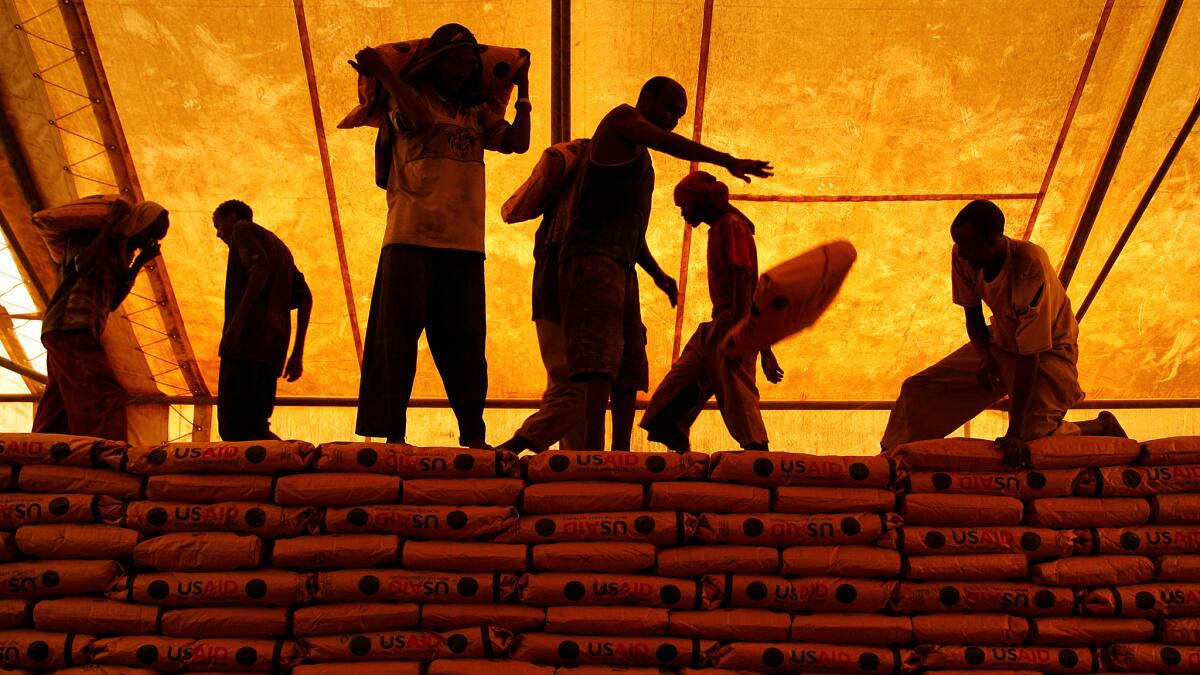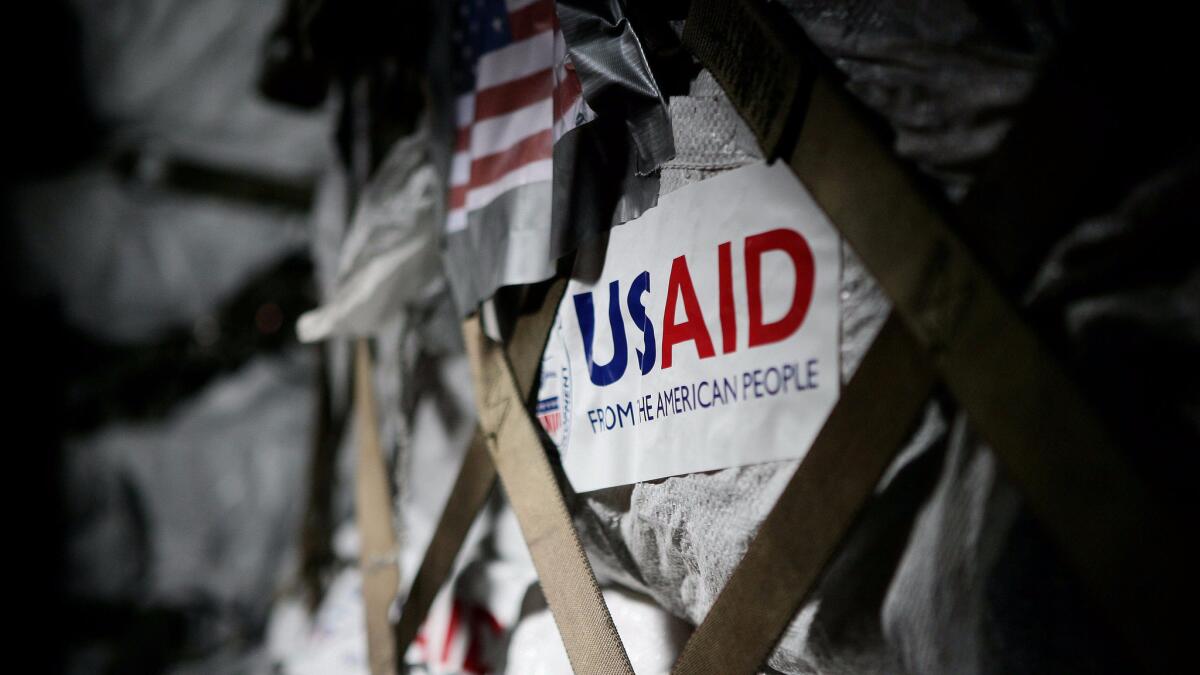Q&A: U.S. development aid — harmful handout or helpful hand up?

- Share via
Prolonged conflict, natural disasters and poor governance are among the obstacles that continue to keep billions of people around the world poor, hungry and living without access to basic amenities such as clean water and electricity.
The United States is among several industrialized nations that provide financial aid to struggling economies in an effort to help stimulate and sustain development.
But according to numerous polls, most Americans believe the country spends far too much on foreign aid and many question whether such assistance does more harm than good by creating dependency abroad and depleting resources that could help fix problems at home.
Gayle Smith, administrator for the U.S. Agency for International Development, is keen to bust the myths about foreign aid.
“First, it’s less than 1%” of the federal budget, Smith told The Times in a recent interview. “Second … the American people provide billions of dollars on their own every year. Third, it’s a really important investment for us.”
Her additional comments have been edited for length and clarity.
Why should Americans support foreign aid?
I think a lot of people can make a national security argument, that if we have a world that is more stable, where countries and societies and communities are developed, where people have access to opportunity, can go to school, can get healthcare, work, [that gives us] better and more able partners with whom we can [work to] deal with some of the threats facing the world.

But we can also see some of the opportunities. There’s a clear interest in peace and stability and the kind of peace and stability that development brings. We are always searching for new markets … that we can buy from [and] sell to. And some of the biggest, fastest emerging markets are in the developing world. So we have an economic interest in having partners with whom we can trade and engage economically.
I think the third reason is a values reason. Every time there’s an earthquake, a crisis, the American people are extraordinary in terms of how much they contribute. I think part of what that does is [show that] together we are saying to the rest of the world, if you’re in trouble, America’s the country that comes to your rescue.
How can foreign aid help stop terrorism?
I think it can play a role, but I don’t think it’s as simple as, if we provide more foreign aid terrorism will stop. I think that if you look at those places in the world where you’ve got transnational threats — terrorism, human trafficking, money laundering, all those dangerous things that spill across borders — most often they are able to flourish in countries where people either don’t have access to opportunity or don’t have equal access to opportunity.
So I think that by investing resources in — not only the well-being of people but their ability to inform the decisions of their daily lives, their ability to have kids who are healthy enough to go to school so that each generation is able to do better and better — over time that protects us, and them, from these types of transnational threats.
How do you respond to those who criticize direct aid to foreign governments?
This is another case where I think the presumption of people is that the way we manage our foreign assistance is to write very big checks to governments. We give very, very little of our assistance directly to governments. We often work in partnership with governments, but we work either through international or local partners.
Where it goes directly to governments, we do all sorts of due diligence to make sure they manage their finances transparently.
What we also do is evaluations [of projects]. The purpose is to genuinely take look and say, are we achieving the outcome we anticipated? And if not, what do we need to do to course correct?

Where do you see progress and how do you measure success?
I think you measure it in different ways and some things you can measure quantitatively. If you look at health for example, we can measure the fact that we have improved nutrition for 18 million kids through the work we’re doing — a combination of our food security and global health work. We can measure that there are over 4.5 million kids alive today because of work in maternal child health that we’ve done.
Particularly in health and agriculture there are tangibles that you can measure.You want to measure what the numbers are. You want to measure whether it’s sustainable, because if we just compensated for the holes created by poverty that wouldn’t be sustainable.
It’s also ownership.
How do you get local actors to do their part and take ownership?
In most cases you don’t have to try very hard because I think there’s an increasingly assertive civil society around the world that doesn’t want somebody to come fix something for them and tell them what to do. They want somebody to come work with them. So I think the demand for local ownership is there.
On the governmental side, there are some governments that are simply not investing in education and health and agriculture and infrastructure, often in cases where you’ve got a great deal of corruption or a conflict.
But … if you look at our food security initiative, for example -- Feed the Future — that was built on a foundation that was created by African leaders who committed themselves to increasing national expenditure on agriculture and agreed that every country should have a comprehensive plan. We took that as an assertion of ownership and responsibility.
Which regions have been particularly successful?
The region that has shown the most leadership in taking development on as a priority has been Africa.
Africa was the only region to have a common African position on the [U.N.] sustainable development goals. Leaders have made commitments on health, on nutrition, on agriculture to what they themselves will do. Now, is it uneven within the broad borders of the continent? Of course it is. There are some who are more serious than others.
You look at Asia and there’s tremendous growth. You look at Latin America and I think we are entering into an era where development will become an increasing priority.
I can look at any region in which we work and point to enough evidence of success to give me a great deal of hope.

Where is work still needed?
I can point to enough challenges to remind me that we’ve got to keep working hard and it’s a constant uphill struggle … whether it’s climate change-induced crises, or the kinds of things we’re seeing in places like South Sudan, where you see other development failures.
I think one of the biggest challenges is development in the Middle East. Part of that is the conflict and crises that exist and their unfolding across the region.
What are some of the headlines in terms of achieving the U.N. sustainable development goals?
If you look at the work we’ve done on maternal child health … there are 4.6 million kids and 200,000 mothers that are alive in part because of our assistance.
I think we have been able to put food security on the world’s agenda. There was a spike in world food prices in 2007/2008. We were able to triple our assistance to just over $3 billion and mobilize an additional $18 billion.
There’s “Power Africa.” The goal is to double access to electricity in Africa. We’ve been able to work with partners to figure out what the obstacle is project by project … so that the private money flows. We have mobilized over $43 billion to work with people to bring these deals to close, so that they will eventually generate electricity.
For more on global development news follow me @AMSimmons1 on Twitter
More to Read
Sign up for Essential California
The most important California stories and recommendations in your inbox every morning.
You may occasionally receive promotional content from the Los Angeles Times.














